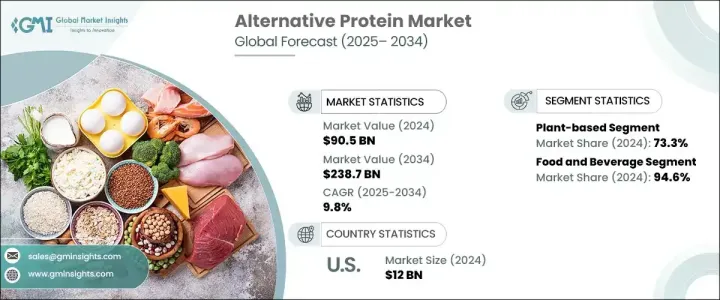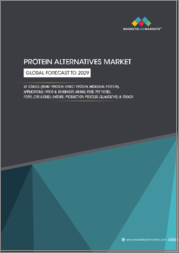
|
시장보고서
상품코드
1716470
대체 단백질 시장 기회, 성장 촉진 요인, 산업 동향 분석, 예측(2025-2034년)Alternative Protein Market Opportunity, Growth Drivers, Industry Trend Analysis, and Forecast 2025 - 2034 |
||||||
세계 대체 단백질 시장은 2024년 905억 달러에 달했고, 2025년부터 2034년까지 연평균 복합 성장률(CAGR)은 9.8%를 보일 것으로 예측됩니다.
이 두드러진 성장의 배경은 지속가능하고 영양가 있는 대체 식품을 찾는 소비자 증가로 인해 더 건강하고 단백질이 풍부한 식품에 대한 선호도가 높아지고 있습니다. 환경의 지속가능성, 동물복지, 개인의 건강에 대한 의식이 높아짐에 따라, 소비자는 식물 유래, 곤충 유래, 배양 세포 단백질에 관심을 보이고 있습니다. 이러한 대체 식품은 진화하는 소비자의 가치에 따라 친환경 솔루션을 제공합니다. 게다가, 보다 건강하고 지속가능한 식량 시스템을 지원하는 국가 정책은 대체 단백질로의 전환을 더욱 강화하고 시장 확대를 위한 유리한 환경을 창출하고 있습니다.

식품업계의 대기업은 다양한 식생활의 선호와 라이프스타일의 선택에 대응하는 혁신적인 단백질 제품을 도입하기 위해 연구개발에 많은 투자를 하고 있습니다. 푸드텍 기업과 기존 식품 브랜드 간의 협업 확대는 대체 단백질의 상용화를 촉진하고, 보다 폭넓은 소비자층에게 보다 친숙하고 매력적이 되고 있습니다. 또한 식품 가공 기술의 지속적인 발전은 대체 단백질 제품의 맛, 식감 및 영양 프로파일을 개선하고 높은 채택율을 촉진합니다.
| 시장 범위 | |
|---|---|
| 시작 연도 | 2024년 |
| 예측 연도 | 2025-2034년 |
| 시작 금액 | 905억 달러 |
| 예측 금액 | 2,387억 달러 |
| CAGR | 9.8% |
식물성 단백질은 광범위한 이용가능성, 확립된 공급망, 채식주의자 및 유연한 소비자들 사이에서 수요가 증가함에 따라 2024년에는 73.3%의 점유율을 차지하고 시장을 독점했습니다. 보다 많은 사람들이 식물 유래의 식습관을 받아들이는 가운데, 제조업체는 이 수요 증가에 대응하기 위해, 다양하고 혁신적인 비건 단백질 제품을 투입하는 것으로 대응하고 있습니다. 식물성 단백질이 계속 이 분야를 선도하는 한편, 곤충 유래, 미생물 유래, 배양 세포 단백질 등, 다른 공급원도 꾸준히 기세를 늘리고 있습니다. 이러한 대체 단백질의 범주는 아직 작지만 기술의 진보로 생산 공정이 개선되고 비용이 절감됨에 따라 점차 시장 점유율을 얻고 있습니다.
식음료 부문은 2024년에 시장 점유율의 94.6%를 차지했으며, 대체 단백질 업계에서 가장 큰 용도 부문이 되었습니다. 유래의 스낵 등, 폭넓은 제품에 짜넣어지고 있습니다. 또한, 스포츠 영양, 의료용 식품, 식사 제한이 있는 사람용의 제품 등, 특수한 식사의 영양 니즈를 채우도록 조정되고 있습니다.
미국의 대체 단백질 시장은 정부의 이니셔티브, 기술 혁신, 견고한 식품 산업에 견인되어 2024년에는 120억 달러를 창출했습니다. 가능한 식생활을 받아들이기 때문에 대체 단백질 제품에 대한 수요는 계속 늘어나고 있습니다. 소셜 미디어, 타겟팅 광고, 식물성 영양에 대한 인식 제고가 소비자 구매 결정에 영향을 미치고 대체 단백질이 소매 및 식품 서비스 부문에서 주목을 받을 수 있도록 돕고 있습니다. 식물성 단백질이나 배양 단백질의 인기가 높아지고 있기 때문에 소매업자는 상품 라인 업을 확대해, 소비자가 지속 가능한 단백질의 다양한 선택지에 간단하게 액세스 할 수 있도록 하고 있습니다. 그 결과, 대체 단백질은 미국 가정의 주식이 되고 있습니다.
목차
제1장 조사 방법과 조사 범위
제2장 주요 요약
제3장 업계 인사이트
- 생태계 분석
- 밸류체인에 영향을 주는 요인
- 이익률 분석
- 혁신
- 장래의 전망
- 제조업체
- 유통업체
- 공급자의 상황
- 이익률 분석
- 주요 뉴스
- 규제 상황
- 영향요인
- 성장 촉진요인
- 가금용 단백질 풍부한 사료는 소화성이 높고, 항영양인자(ANFS)를 별로 포함하지 않습니다.
- 이 지역으로부터의 쇠고기 수출 증가가 업계의 성장을 가속합니다.
- 산업용 가축 생산 증가가 사료용 단백질 수요를 촉진합니다.
- 고단백질을 포함한 건강한 제품에 대한 수요 증가
- 조류 제품의 생산을 촉진하는 정부의 이니셔티브가 조류 기반의 단백질 시장 성장을 지원한다
- 식용 곤충의 식품 용도에의 채용이 증가해, 곤충 유래 단백질 시장의 성장을 지지한다
- 채식주의에 대한 의식의 고조
- 업계의 잠재적 위험 및 과제
- 식용 곤충은 식품 산업용도에 있어서의 규제가 명확하지 않기 때문에 곤충 베이스의 단백질의 성장이 제한됩니다.
- 식물 기반 및 곤충 기반과 같은 다양한 대체 단백질과 관련된 알레르기
- 엄격한 사료 규제
- 성장 촉진요인
- 성장 가능성 분석
- Porter's Five Forces 분석
- PESTEL 분석
제4장 경쟁 구도
- 소개
- 기업 점유율 분석
- 경쟁 포지셔닝 매트릭스
- 전략 전망 매트릭스
제5장 시장 추정 및 예측 : 원료별, 2021년-2034년
- 주요 동향
- 플랜트 베이스
- 분리 대두단백
- 농축 대두단백
- 발효 대두 단백질
- 덕위드·프로테인
- 기타
- 곤충 베이스
- 미생물 기반
- 박테리아
- 효모
- 조류
- 균류
- 기타
- 기타
제6장 시장 추정 및 예측 : 용도별, 2021년-2034년
- 주요 동향
- 음식
- 육류 유사품
- 베이커리
- 유제품 대체품
- 시리얼 & 스낵
- 음료
- 기타
- 사료
- 가금
- 육계
- 레이어
- 칠면조
- 돼지
- 스타터
- 글로어
- 종돼지
- 소
- 젖소
- 송아지
- 수산 양식
- 연어
- 매스
- 새우
- 잉어
- 반려동물 식품
- 말고기
- 기타
- 가금
제7장 시장 추정 및 예측 : 지역별, 2021년-2034년
- 주요 동향
- 북미
- 미국
- 캐나다
- 유럽
- 독일
- 영국
- 프랑스
- 스페인
- 이탈리아
- 네덜란드
- 아시아태평양
- 중국
- 인도
- 일본
- 호주
- 한국
- 라틴아메리카
- 브라질
- 멕시코
- 아르헨티나
- 중동 및 아프리카
- 사우디아라비아
- 남아프리카
- 아랍에미리트(UAE)
제8장 기업 프로파일
- AB Mauri
- AMCO Proteins
- Angel Yeast
- Archer Daniel Midland Company
- Axiom Foods
- Calysta Inc.
- Cargill Incorporation
- Darling Ingredients
- Hamlet Protein
- Ingredion
- Innovafeed
- Lallemand Inc
- Royal DSM NV
- Ynsect
The Global Alternative Protein Market generated USD 90.5 billion in 2024 and is projected to grow at a CAGR of 9.8% between 2025 and 2034. This remarkable growth is fueled by an increasing consumer preference for healthier, protein-rich foods as individuals seek sustainable and nutritious alternatives. As awareness around environmental sustainability, animal welfare, and personal health gains momentum, consumers are gravitating toward plant-based, insect-based, and cultured cell proteins. These alternatives offer eco-friendly solutions that align with evolving consumer values. In addition, national policies supporting healthier and more sustainable food systems are further propelling this shift toward alternative proteins, creating a favorable environment for market expansion.

Major food industry players are investing heavily in research and development to introduce innovative protein products catering to diverse dietary preferences and lifestyle choices. Growing collaborations between food tech companies and established food brands are driving the commercialization of alternative proteins, making them more accessible and appealing to a broader consumer base. Additionally, ongoing advancements in food processing technologies are improving the taste, texture, and nutritional profile of alternative protein products, encouraging higher adoption rates.
| Market Scope | |
|---|---|
| Start Year | 2024 |
| Forecast Year | 2025-2034 |
| Start Value | $90.5 Billion |
| Forecast Value | $238.7 Billion |
| CAGR | 9.8% |
Plant-based proteins dominated the market in 2024, holding a 73.3% share due to their wide availability, established supply chains, and rising demand among vegan and flexitarian consumers. As more people embrace plant-based eating habits, manufacturers are responding by introducing a diverse range of innovative vegan protein products to meet this growing demand. While plant-based proteins continue to lead the segment, other sources, including insect-based, microbial-based, and cultured cell proteins, are steadily gaining momentum. These alternative protein categories remain smaller but are gradually capturing market share as technological advancements improve their production processes and reduce costs.
The food and beverage segment contributed 94.6% of the market share in 2024, making it the largest application segment within the alternative protein industry. As consumers increasingly seek ethical and sustainable food sources, manufacturers are expanding their portfolios to include various alternative protein products. These proteins are being integrated into a wide range of offerings, including meat substitutes, dairy-free beverages, and plant-based snacks. Additionally, they are being tailored to meet the nutritional needs of specialty diets, such as sports nutrition, medical foods, and products for individuals with dietary restrictions. The growing emphasis on sustainability and ethical sourcing has led to increased adoption of alternative proteins across multiple consumer segments, creating new opportunities for product diversification.
The U.S. alternative protein market generated USD 12 billion in 2024, driven by government initiatives, technological innovations, and a robust food industry. As more consumers in the U.S. embrace health-conscious and environmentally sustainable diets, the demand for alternative protein products continues to grow. Social media, targeted advertising, and heightened awareness around plant-based nutrition are influencing consumer purchasing decisions and helping alternative proteins gain traction in the retail and food service sectors. The increasing popularity of plant-based and cultured protein options is encouraging retailers to expand their offerings, ensuring that consumers have easy access to a variety of sustainable protein choices. As a result, alternative proteins are becoming a staple in American households, contributing to the rapid growth of the U.S. market.
Table of Contents
Chapter 1 Methodology & Scope
- 1.1 Market scope & definition
- 1.2 Base estimates & calculations
- 1.3 Forecast calculation
- 1.4 Data sources
- 1.4.1 Primary
- 1.4.2 Secondary
- 1.4.2.1 Paid sources
- 1.4.2.2 Public sources
- 1.5 Primary research and validation
- 1.5.1 Primary sources
- 1.5.2 Data mining sources
Chapter 2 Executive Summary
- 2.1 Industry synopsis, 2021-2034
Chapter 3 Industry Insights
- 3.1 Industry ecosystem analysis
- 3.1.1 Factor affecting the value chain
- 3.1.2 Profit margin analysis
- 3.1.3 Disruptions
- 3.1.4 Future outlook
- 3.1.5 Manufacturers
- 3.1.6 Distributors
- 3.2 Supplier landscape
- 3.3 Profit margin analysis
- 3.4 Key news & initiatives
- 3.5 Regulatory landscape
- 3.6 Impact forces
- 3.6.1 Growth drivers
- 3.6.1.1 Protein rich diets for poultry are highly digestible and devoid of containing less anti-nutritional factors (ANFS)
- 3.6.1.2 Rising beef exports from the region will foster industry growth
- 3.6.1.3 Growing industrial livestock production will drive animal feed protein demand
- 3.6.1.4 Rising demand for healthy products with high protein content
- 3.6.1.5 Government initiatives to boost algae products production, supporting the algae-based protein market growth
- 3.6.1.6 Rising adoption of edible insects in food application to support the insect-based protein market growth
- 3.6.1.7 Increasing awareness towards vegan diet
- 3.6.2 Industry pitfalls & challenges
- 3.6.2.1 Edible insects have a lack of regulatory clarity in the food industry applications restricting the insect-based protein growth
- 3.6.2.2 Allergies associated with different alternative proteins such as plant-based and insect-based
- 3.6.2.3 Stringent feed regulatory compliances
- 3.6.1 Growth drivers
- 3.7 Growth potential analysis
- 3.8 Porter's analysis
- 3.9 PESTEL analysis
Chapter 4 Competitive Landscape, 2024
- 4.1 Introduction
- 4.2 Company market share analysis
- 4.3 Competitive positioning matrix
- 4.4 Strategic outlook matrix
Chapter 5 Market Estimates and Forecast, By Source, 2021–2034 (USD Billion) (Kilo Tons)
- 5.1 Key trends
- 5.2 Plant-based
- 5.2.1 Soy protein isolates
- 5.2.2 Soy protein concentrates
- 5.2.3 Fermented soy protein
- 5.2.4 Duckweed protein
- 5.2.5 Others
- 5.3 Insect-based
- 5.4 Microbial-based
- 5.4.1 Bacteria
- 5.4.2 Yeast
- 5.4.3 Algae
- 5.4.4 Fungi
- 5.4.5 Others
- 5.5 Others
Chapter 6 Market Estimates and Forecast, By Application, 2021–2034 (USD Billion) (Kilo Tons)
- 6.1 Key trends
- 6.2 Food & beverage
- 6.2.1 Meat analogs
- 6.2.2 Bakery
- 6.2.3 Dairy alternatives
- 6.2.4 Cereals & snacks
- 6.2.5 Beverages
- 6.2.6 Others
- 6.3 Animal feed
- 6.3.1 Poultry
- 6.3.1.1 Broiler
- 6.3.1.2 Layer
- 6.3.1.3 Turkey
- 6.3.2 Swine
- 6.3.2.1 Starter
- 6.3.2.2 Grower
- 6.3.2.3 Sow
- 6.3.3 Cattle
- 6.3.3.1 Dairy
- 6.3.3.2 Calf
- 6.3.4 Aquaculture
- 6.3.4.1 Salmon
- 6.3.4.2 Trout
- 6.3.4.3 Shrimps
- 6.3.4.4 Carp
- 6.3.5 Pet food
- 6.3.6 Equine
- 6.3.7 Others
- 6.3.1 Poultry
Chapter 7 Market Estimates and Forecast, By Region, 2021–2034 (USD Billion) (Kilo Tons)
- 7.1 Key trends
- 7.2 North America
- 7.2.1 U.S.
- 7.2.2 Canada
- 7.3 Europe
- 7.3.1 Germany
- 7.3.2 UK
- 7.3.3 France
- 7.3.4 Spain
- 7.3.5 Italy
- 7.3.6 Netherlands
- 7.4 Asia Pacific
- 7.4.1 China
- 7.4.2 India
- 7.4.3 Japan
- 7.4.4 Australia
- 7.4.5 South Korea
- 7.5 Latin America
- 7.5.1 Brazil
- 7.5.2 Mexico
- 7.5.3 Argentina
- 7.6 Middle East and Africa
- 7.6.1 Saudi Arabia
- 7.6.2 South Africa
- 7.6.3 UAE
Chapter 8 Company Profiles
- 8.1 AB Mauri
- 8.2 AMCO Proteins
- 8.3 Angel Yeast
- 8.4 Archer Daniel Midland Company
- 8.5 Axiom Foods
- 8.6 Calysta Inc.
- 8.7 Cargill Incorporation
- 8.8 Darling Ingredients
- 8.9 Hamlet Protein
- 8.10 Ingredion
- 8.11 Innovafeed
- 8.12 Lallemand Inc
- 8.13 Royal DSM NV
- 8.14 Ynsect


















